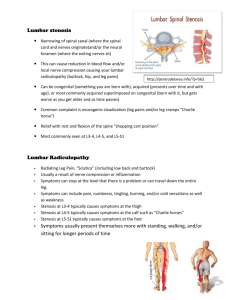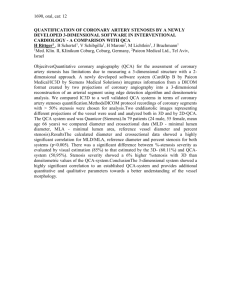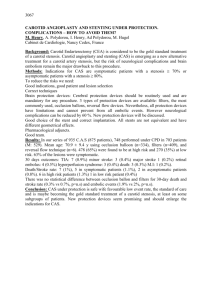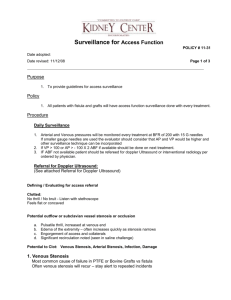Document 13308635
advertisement
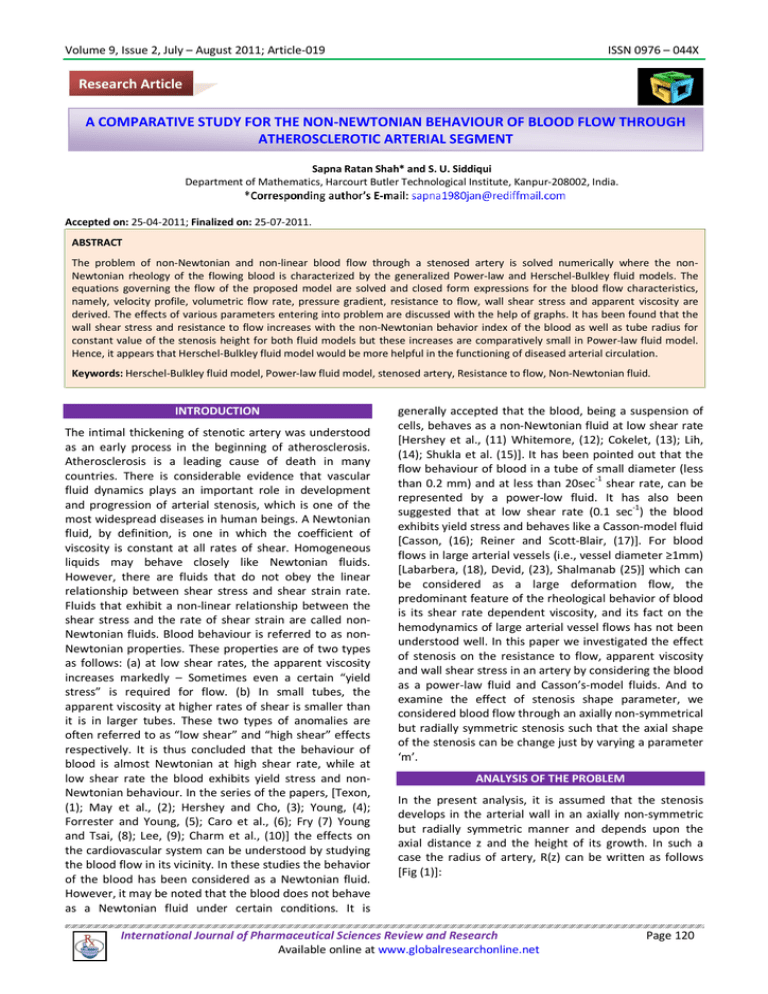
Volume 9, Issue 2, July – August 2011; Article-019 ISSN 0976 – 044X Research Article A COMPARATIVE STUDY FOR THE NON-NEWTONIAN BEHAVIOUR OF BLOOD FLOW THROUGH ATHEROSCLEROTIC ARTERIAL SEGMENT Sapna Ratan Shah* and S. U. Siddiqui Department of Mathematics, Harcourt Butler Technological Institute, Kanpur-208002, India. Accepted on: 25-04-2011; Finalized on: 25-07-2011. ABSTRACT The problem of non-Newtonian and non-linear blood flow through a stenosed artery is solved numerically where the nonNewtonian rheology of the flowing blood is characterized by the generalized Power-law and Herschel-Bulkley fluid models. The equations governing the flow of the proposed model are solved and closed form expressions for the blood flow characteristics, namely, velocity profile, volumetric flow rate, pressure gradient, resistance to flow, wall shear stress and apparent viscosity are derived. The effects of various parameters entering into problem are discussed with the help of graphs. It has been found that the wall shear stress and resistance to flow increases with the non-Newtonian behavior index of the blood as well as tube radius for constant value of the stenosis height for both fluid models but these increases are comparatively small in Power-law fluid model. Hence, it appears that Herschel-Bulkley fluid model would be more helpful in the functioning of diseased arterial circulation. Keywords: Herschel-Bulkley fluid model, Power-law fluid model, stenosed artery, Resistance to flow, Non-Newtonian fluid. INTRODUCTION The intimal thickening of stenotic artery was understood as an early process in the beginning of atherosclerosis. Atherosclerosis is a leading cause of death in many countries. There is considerable evidence that vascular fluid dynamics plays an important role in development and progression of arterial stenosis, which is one of the most widespread diseases in human beings. A Newtonian fluid, by definition, is one in which the coefficient of viscosity is constant at all rates of shear. Homogeneous liquids may behave closely like Newtonian fluids. However, there are fluids that do not obey the linear relationship between shear stress and shear strain rate. Fluids that exhibit a non-linear relationship between the shear stress and the rate of shear strain are called nonNewtonian fluids. Blood behaviour is referred to as nonNewtonian properties. These properties are of two types as follows: (a) at low shear rates, the apparent viscosity increases markedly – Sometimes even a certain “yield stress” is required for flow. (b) In small tubes, the apparent viscosity at higher rates of shear is smaller than it is in larger tubes. These two types of anomalies are often referred to as “low shear” and “high shear” effects respectively. It is thus concluded that the behaviour of blood is almost Newtonian at high shear rate, while at low shear rate the blood exhibits yield stress and nonNewtonian behaviour. In the series of the papers, [Texon, (1); May et al., (2); Hershey and Cho, (3); Young, (4); Forrester and Young, (5); Caro et al., (6); Fry (7) Young and Tsai, (8); Lee, (9); Charm et al., (10)] the effects on the cardiovascular system can be understood by studying the blood flow in its vicinity. In these studies the behavior of the blood has been considered as a Newtonian fluid. However, it may be noted that the blood does not behave as a Newtonian fluid under certain conditions. It is generally accepted that the blood, being a suspension of cells, behaves as a non-Newtonian fluid at low shear rate [Hershey et al., (11) Whitemore, (12); Cokelet, (13); Lih, (14); Shukla et al. (15)]. It has been pointed out that the flow behaviour of blood in a tube of small diameter (less than 0.2 mm) and at less than 20sec-1 shear rate, can be represented by a power-low fluid. It has also been suggested that at low shear rate (0.1 sec-1) the blood exhibits yield stress and behaves like a Casson-model fluid [Casson, (16); Reiner and Scott-Blair, (17)]. For blood flows in large arterial vessels (i.e., vessel diameter ≥1mm) [Labarbera, (18), Devid, (23), Shalmanab (25)] which can be considered as a large deformation flow, the predominant feature of the rheological behavior of blood is its shear rate dependent viscosity, and its fact on the hemodynamics of large arterial vessel flows has not been understood well. In this paper we investigated the effect of stenosis on the resistance to flow, apparent viscosity and wall shear stress in an artery by considering the blood as a power-law fluid and Casson’s-model fluids. And to examine the effect of stenosis shape parameter, we considered blood flow through an axially non-symmetrical but radially symmetric stenosis such that the axial shape of the stenosis can be change just by varying a parameter ‘m’. ANALYSIS OF THE PROBLEM In the present analysis, it is assumed that the stenosis develops in the arterial wall in an axially non-symmetric but radially symmetric manner and depends upon the axial distance z and the height of its growth. In such a case the radius of artery, R(z) can be written as follows [Fig (1)]: International Journal of Pharmaceutical Sciences Review and Research Available online at www.globalresearchonline.net Page 120 Volume 9, Issue 2, July – August 2011; Article-019 ISSN 0976 – 044X Where u is the axial velocity, µ is the viscosity of fluid, (dp/dz) is the pressure gradient and n is the flow behaviour index of the fluid. where R(z) and R0 is the radius of the artery with and without stenosis, respectively. L0 is the stenosis length and d indicates its location, m ≥ 2 is a parameter determining the stenosis shape and is referred to as stenosis shape parameter. Axially symmetric stenosis occurs when m = 2, and a parameter A is given by; A = δ m m /(m -1 ) , where δ denotes the maximum R 0 Lm0 (m - 1) height of stenosis at z = d + L0 / m1 / (m – 1). r ' axis Solving for u from equation (2), (4) and using the boundary conditions (3), we have, P du = dr 2µ 1 /n [(r - R C )1 /n ], (5) The volumetric flow rate Q can be defined as, R R du Q 2 π u r dr π r d r, dr 0 0 (6) By the help of equations (5) and (6) we have, Q ( Z ' axis P 1 /n nπ ) 2µ (3 n 1 ) [(1 /n ) 1 ] (R ) (7) From equation (7) pressure gradient is written as follows, Lo n dp 1 (3 n 1 ) 2µ Q dz nπ (R )3n 1 d L Figure 1: Stenotic Artery The equation of motion for laminar and incompressible, steady, fully-developed, one-dimensional flow of blood whose viscosity varies along the radial direction in an artery reduces to [Young, (4)]: P 1 (r τ ) 0 r r z P 0 , r , (2) Following boundary conditions are introduced to solve the above equations, at r = 0 u = 0 at r = R (z ) τ at r = 0 is f i n i te P = P0 at z = 0 P = PL at z = L (3) (3 n 1 ) PL P0 Q nπ n L 2µ 3n +1 R 0 0 (9) dz 1 3n R /R 0 λ= P L - P0 Q (10) The resistance to flow from equation (10) using equations (9) can write as: n d L0 L 2µ d dz (3n 1)Q λ0 3n1 dz 3n 1 dz nπ QR 0 0 0 d L0 R R0 (11) When there is no stenosis in artery then R = R0, the resistance to flow, n λN Case-1: Power-law Fluid Model: Non-Newtonian fluid is that of power-law fluid which have constitutive equation, 1 /n τ du = f ( τ ) , µ dr R d p c w h ere τ dz 2 Integrating equation (8) using the condition P = P0 at z = 0 and P = PL at z = L. We have, The resistance to flow (resistive impedance) is denoted by λ and defined as follows: where (z, r) are co-ordinates with z measured along the axis and r measured normal to the axis of the artery. u / r = 0 (8) (12) From equation (11) and (12) the ratio of (0 / N) is given as; λ = (4) 2µ (3 n 1 ) Q 3 n 1 L nπ QR0 λ0 λN 1 L0 L 1 L d L d 0 (13) dz R /R 0 3n 1 Now the ratio of shearing stress at the wall can be written as; International Journal of Pharmaceutical Sciences Review and Research Available online at www.globalresearchonline.net Page 121 Volume 9, Issue 2, July – August 2011; Article-019 τN R 0 R τR τN 1.006 3n (14) 1 (15) δ 1- R 0 n1 1.005 Resistance to flow τR ISSN 0976 – 044X 3n 1.004 n 2/3 1.003 n 1/ 3 1.002 1.001 1 0.999 1 Resistance to flow 1.03 n 1 1.025 1.02 n 1/ 3 1.01 1.005 1 0.1 0.3 0.5 0.7 0.9 Stenosis size Figure 2: Variation of resistance to flow with stenosis size for different values of n 9 4 Wall shear stress 3.5 n1 m3 3 2.5 2 n 2/3 1.5 n 1/ 3 1 0.5 0.1 0.2 0.3 0.4 0.5 0.6 Stenosis length Figure 4: Variation of wall shear stress with stenosis length for different values of flow behavior index (n) 2.4 n1 2.2 2 n 2/3 1.8 n 1/ 3 1.6 1.4 1.2 1 0 0.1 0.2 0.3 0.4 Stenosis size Figure 5: Variation of wall shear stress with stenosis size for different values n Case-2: Herschel-Bulkley Fluid Model- The stress-strain relation of Herschel-Bulkley fluid is given as: du n f ( τ) τ τ , dr µ du f ( τ) , dr dp r where τ , dz n 2/3 1.015 3 5 7 Stenosis shape parameter Figure 3: Variation of resistance to flow with stenosis shape parameter for different values of n Wall shear stress Fig.2 reveals the variation of resistance to flow () with stenosis size (/R0) for different values of flow behavior index (n). It is observed that the resistance to flow increases as stenosis size increases. It is also noticed here that resistance to flow increases as flow behavior index n increases. It is seen from the Fig.2, Fig.3 that the ratio is always greater than 1 and decreases as n decreases from unity. This result is similar with the result of [Shukla, et al., (15)]. In Fig.3, resistance to flow decreases as stenosis shape parameter increases and maximum resistance to flow occurs at (m = 2), i. e. in case of symmetric stenosis. This result is therefore consisting to the result of [Haldar, (19)]. In Fig.4 the variation of wall shear stress () with stenosis length for different values of flow behavior index n has been shown. This figure depicts that wall shear stress increases as stenosis length increases. Also it has been seen from this graph that the wall shear stress increases as value of flow behavior index n increases. As the stenosis grows, the wall shearing stress increases in the stenotic region. It is also noted that the shear ratio given by (15) is greater than one and decreases as n decreases (n < 1). These results are similar with the results of [Shukla, et al., (15)]. Fig.5 shows the variation of wall shear stress with stenosis size for different values of flow behavior index n. This figure depicts that wall shear stress increases as stenosis size increases. Also it has been seen from this graph that the wall shear stress increases as value of flow behavior index n increases. These results are consistent to the observation of [Shukla, et al., (15)]. It is also seen that the shear ratio is always greater than one and decreases as n decreases. For /R0 = 0.1 the increases in wall shear due to stenosis is about 37% when compared to the wall shear corresponding to the normal artery in the Newtonian case (n = 1), but for n = 2/3 this increase is only 23% approximately. However, for /R0 = 0.2, the corresponding increase in Newtonian (n = 1) and non-Newtonian (n = 2/3) cases are 95% and 56% respectively. τ τ (16) τ τ dp R c τ , dz and µ denotes Herschel-Bulkley viscosity coefficient, o is yield stress, is shear stress, Rc is the radius of the plug-flow region, u is the axial velocity along the z direction and n is the flow behavior index. The relation correspond to the vanishing of the velocity gradients in regions, in which the shear stress τ is less than the yield stress τo this implies a plug flow wherever τ ≤ τo when the International Journal of Pharmaceutical Sciences Review and Research Available online at www.globalresearchonline.net Page 122 Volume 9, Issue 2, July – August 2011; Article-019 ISSN 0976 – 044X shear rates in the fluid are very high, τ ≥ τo, the power-law fluid behavior is indicated. 0 1/ n r - R c 1/ n , (17) the flow of flux, Q, is defined as, R R Q= 2 p u r dr = p r 2 - (d u / d r) dr, (18) 0 0 substituting the value of f () from equation (1) in equation (7), π P Q = 2 2µ (3 + 1 ) 1/ n n R f (y), (1 + 1n ) (19) Rc ((1/ n)1) R 4 4 ) (1 c )((1/ n)2) R ((1 / n) 2) R ((1 / n) 2)((1 / n) 3) R R ((1 c )((1/ n)3) ((1)((1/ n)3) ( c )))], R R where f (y) [2(1 2Q 2µ dp P = (1 + n1 ) = (1 + 3 n ) dz R π f (y) n (20) to determine λ, we integrate equation (11) for the pressure PL and Po are the pressure at z = 0 and z = L, respectively, where L is the length of the tube. ΔP = PL - P0 = 2µ 2Q 1n +1 π R1+3n 0 1+3 n µ app = (1/(R(z)/R ) By equation (1) and (3) we get, p du =- dr 2µ The apparent viscosity (0/) is defined as follow: n L (21) dz 0 (R(z)/R )(1+3n) f(y) n 0 Fig.6 shows the variation of resistance to flow () with stenosis shape parameter (m) for stenosis size (/R0). It is seen from the figure that the resistance to flow decreases as stenosis shape parameter m increases (for n=1/3). Maximum resistance to flow occurs at m = 2. i e. in the case of symmetric stenosis. This result is therefore consistent with the observation of [Mishra, (26)]. Fig.7 depicts the variation of wall shear stress with stenosis length (L0/L) for different values of stenosis shape parameter. Figure shows that wall shear stress increases as stenosis length increases and decreases as stenosis shape parameter increases (for n=2/3). This result is qualitative agreement with [19]. Fig.8 represents variation of apparent viscosity with stenosis shape parameter (for n=1/3). Figure depicts that apparent viscosity decreases as stenosis shape parameter increases but this increase is less due to non-Newtonian behaviour of the blood. In addition it may be noted from the graph that the apparent viscosity increases as Stenosis size increases. This result is in qualitative agreement with the result of [Pontrelli, (20)]. It may be observed that from these results that the apparent viscosity increases as the stenosis grows and remains constants outside from the stenotic region. Fig.9 shows the variation of apparent viscosity with stenosis length for different values of stenosis shape parameter (m). We observe that the apparent viscosity sharply increases as length of stenosis increases. The resistance to flow is given by the coefficient λ is defined as follows: 2µ n R 1+3 0 2 Q (1 + n1 ) (M ) π d dz M = n + 0 f 0 d + L0 d L dz R (z) R 0 (23) + 1+ 3 n f(y) n d+ L0 d z (f 0 ) n (1+1n) (2+1n) (3+1n) (3+1) 4 4 f0 =2 1-(Rc/R0) 1-(Rc/R0) + - (-1) n (Rc/R0) 1-(Rc/R0) 1 1 1 (2+ )(3+ ) ( +2) n n n When there is no stenosis in artery then R = R0, the resistance to flow, λN = 2 µ 2 Q (1 + 1n ) 3n π R 1+ 0 n L (f 0 ) n (24) from equation (12) and (13) the ratio of ( / N ) is given as: λ= 0 N = 1- L0 L + (f 0 ) n L d + L0 d dz 1+3 n (R(z)/R o ) f(y) n (25) / Ro 0.2 0.185 / Ro 0.4 0.18 / Ro 0.6 0.175 / Ro 0.8 0.17 0.165 0 2 4 6 8 10 Shape parameter (m) Figure 6: Variation of resistance to flow with shape parameter for different values of stenosis size 1200 wall shear stress n λ0 = 0.19 Resistance to flow (22) λ = (PL - P0 /Q) (26) f(y)) m 2 1000 m 3 800 m 4 600 m5 m 6 m 7 m 8 400 200 0 - 0.10 0.20 0.30 0.40 Stenosis length 0.50 0.60 Figure 7: Variation wall shear stress with stenosis length for different values of shape parameter International Journal of Pharmaceutical Sciences Review and Research Available online at www.globalresearchonline.net Page 123 Volume 9, Issue 2, July – August 2011; Article-019 ISSN 0976 – 044X REFERENCES 0.07 / Ro 01 . 1. Apparent viscosity 0.06 / Ro 0.2 0.05 / Ro 0.3 0.04 / Ro 0.4 / Ro 0.5 / Ro 0.6 / Ro 0.7 0.03 0.02 Advances in Math. 208 (2003), pp. 13--26. 2. May, A . G . , De we e s e , J . A . an d R o b , C. B. , H e mo d yn ami c e ff e c t s o f art e ri al s t e n o si s. Su rg e ry, ( 1963) . 53: 513 - 524. 3. H e rs h e y, D. , Ch o , S. J . , B l o o d f l o w i n ri g id t u b e s : T h i c kn e ss an d s l i p ve l o c it y of p l as ma f i l m. J. A p pl i . P h ysi o l o . ( 1966) . 21:27. 4. Young, D. F., Effects of a time-dependent stenosis on flow through a tube. J. Eng. India. Trans. ASME. (1968).90: 248-254. 5. Forrester, J. H. and Young, D. F., Flow through a converging diverging tube and its implications in occlusive vascular disease. J. Biomech. (1970).3: 297-316. 6. Caro, C. G., Fitz-Gerald J. M., and Schroter R. C., Atheroma and arterial wall shear observation, Proc. R. Soc. (1971). 177: 109-159. 7. Fry, D. L., Localizing factor in arteriosclerosis, New York: Grune Stratton. 2005.85. 8. Young, D. F. and Tsai, F. Y., Flow characteristics in models of arterial stenosis–II, unsteady flow. J. Biomech. (1973).6: 547-558. 9. Lee, J. S., On the coupling and detection of motion between an artery with a localized lesion and its surrounding tissue. J. Biomech. (1974).7: 403. 10. Charm, S. E., and Kurland G. S., Viscometry of human -1 blood for shear rate of 100,000sec . Nature London. (1965).206: 617-618. 11. Hershey, D., Blood rheology: Temperature dependence. A.I.Ch.E. Boston (1964). 12. Whitmore R. L., Rheology of the circulation, Perg New York (1968). 13. Cokelet, G. R., The rheology of human blood. In Biomechanics, Ed. By Y. C. Fung et al., 63, Englewood Cliffs: Prentice-Hall, (1972). 14. Lih, M.M, Transport Phenomena in Biology. Wiley, New York, (1975). 15. Shukla, J. B., Parihar, R. S., Gupta, S. P.,Biorheological aspects of blood flow through artery with mild stenosis. Biorhe. (1990).17:403-410. 16. Casson, N. A, flow equation for pigment oil suspensions of the printing ink type. In Rheology of disperse systems, Ed. Mill., C.C., London. (1959).84-102. 17. Reiner, M. and Scott Baldair G.W., The flow of the blood through narrow tube. Nature, London, (1959).184: 354359, 18. Labarbera, M., Principles of design systems,Science. (2004).49: 92-100. 19. Haldar, K., Effects of the shape of stenosis on the resistance to blood flow through an artery. Bull. Mathe. Bio. (1985). 47: 545-550. 0.01 0 0 2 4 6 8 10 shape parameter Apparent viscosity Figure 8: Variation of apparent viscosity with stenosis shape parameter for different values of stenosis size decreases as stenosis shape parameter m increases for (n=2/3). [Tandon, et al., (21)] have also noted the same results. 0.02 0.018 0.016 0.014 0.012 0.01 0.008 0.006 0.004 0.002 0 m2 m3 m 4 0 T e xo n , M. , A h o mo d yn ami c c o n c e p t o f at h e ro s c l e ro s i s wit h p art i c u l ar re f e re n c e to c o ro n ary o c c l u s i o n . 99. 418: ( 1957 R.M. Aiex, Conjectured statistics for the q, t -Catalan numbers, 0.05 0.1 0.15 Stenosis length Figure 9: Variation of apparent viscosity with Lo/L for different values of stenosis shape parameter CONCLUSION In this paper, we have studied the effects of the stenosis in an artery by considering the blood as power-law and Herscel-Bulkley fluid model. It has been concluded that the resistance to flow and wall shear stress increases as the size of stenosis increases for a given non-Newtonian model of the blood. The flow resistance decreases with increasing values of shape parameter ‘m’ and attains its maximal in the symmetric stenosis case (m=2) for any given stenosis size. Thus the increasing value of the shape parameter would cause a considerable increase in the flow of blood. It has been found that the wall shear stress and resistance to flow increases with the non-Newtonian behavior index of the blood as well as tube radius for constant value of the stenosis height for both fluid models but these increases are comparatively small in Power-law fluid model. Hence, it appears that HerschelBulkley fluid model would be more helpful in the functioning of diseased arterial circulation. Acknowledgment: Authors gratefully acknowledge the financial assistance from the UGC major research project No.37-493/2009(SR) for this work. International Journal of Pharmaceutical Sciences Review and Research Available online at www.globalresearchonline.net of fluid Page 124 Volume 9, Issue 2, July – August 2011; Article-019 20. 21. 22. 23. ISSN 0976 – 044X Pontrelli, G., “Blood flow through an axisymmetric stenosis”, Proc. Inst Mech. Eng, Part H, Eng Med., (2001).215: 1-10. Tandon, P. N., Nirmala, P., Tewari, M. and Rana, U. S., Analysis of nutritional transport through a capillary: Normal and stenosed. Compu. Math. Appli. 22. (1991). 12: 3-13, R ac h i d , H . , O u az z an i M. T . , “ T h e e f f e c t of p u l s at i l e f l o w o n p e ri s t alt i c o u t pu t : Cas e of a N e wt o n i an f l u i d” St u d i e s T h e o r. P h ys . ( 2008). 6, 29- 30. Me c h . ( 2007) . 39- 43. 24. San kar, D. S. an d H e mal at , K . , “ P u l s at i l e f l ow o f H e rs c h e l- B u l ke y f lu i d t h ro u g h s te n o s ed art e ri e s I n te r. J . N o n -l i n e r Me c h . ( 2006) . 41, 979- 990. 25. Shalmanab, E, Rosenfelda,D “Numerical modeling of the flow in stenosed coronary artery”, T h e o r. P h ys. (2009).12, 589-602. 26. Mshira, B. K., Pradhan, “Effect of shear stress, Resistance and flow rate across mild stenosis on blood flow through blood vessels”, The Cardiology (2010).Vol. 5(1), pp 4-11. Davi d , N . K u . ,“ B l o o d fl o w i n art e ri e s ” Fl u id ************** International Journal of Pharmaceutical Sciences Review and Research Available online at www.globalresearchonline.net Page 125

